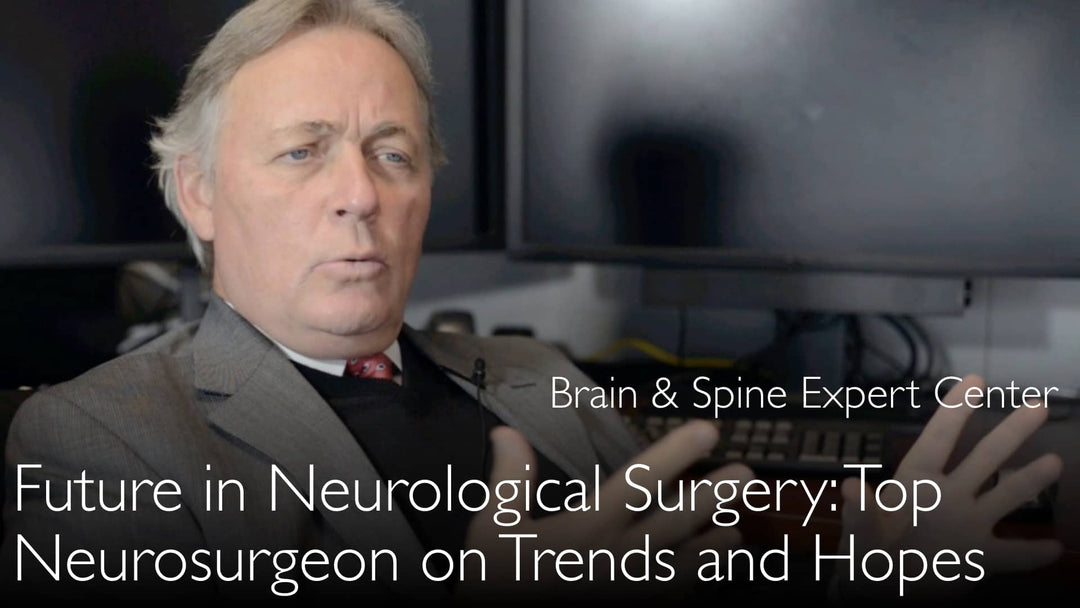Leading expert in cerebrovascular neurosurgery and minimally invasive brain surgery, Dr. Arthur Day, MD, explains how future advances will focus on less invasive procedures, combining endovascular and open surgical techniques to treat brain aneurysms, tumors, and vascular malformations earlier and more effectively, while emphasizing that the neurosurgeon's essential role in direct intervention will remain critical.
Future of Neurosurgery: Minimally Invasive Brain Aneurysm and Tumor Treatment Advances
Jump To Section
- Multimodality Therapy is Key
- Minimally Invasive Procedures Rise
- Endovascular Aneurysm Repair
- Neurosurgeon Role Remains Essential
- Earlier Treatment and Prevention
- Skills and Technology Integration
- Conclusion: Future Benefits for Patients
Multimodality Therapy is Key
Dr. Arthur Day, MD, highlights that the evolution of neurosurgery is moving firmly in the direction of combining treatment modalities. This multi-modality therapy approach is fundamental to the successful treatment of complex brain diseases like tumors, aneurysms, and arteriovenous malformations (AVMs). The future involves integrating the best techniques from endovascular procedures, microsurgery, and radiation to create comprehensive, patient-specific treatment plans.
Minimally Invasive Procedures Rise
A major trend in neurological surgery is the shift toward increasingly less invasive procedures. Dr. Arthur Day, MD, explains that these advances mean surgeons often no longer need to make large openings in the skull. This results in more attractive cosmetic outcomes and potentially faster recovery times for patients. The field is changing rapidly due to significant technological advances and accumulating surgical experience, which continually refines these techniques.
Endovascular Aneurysm Repair
A critical advancement is the ability to treat brain aneurysms before they rupture using endovascular catheters. Dr. Arthur Day, MD, states that repairing a potential problem through a catheter is better for everybody. This approach involves threading a thin tube through the blood vessels to the site of the aneurysm in the brain, often to place coils or a flow diverter, thereby preventing a life-threatening hemorrhage without open brain surgery.
Neurosurgeon Role Remains Essential
Despite technological progress, Dr. Day is clear that there is no substitute for a neurosurgeon's skill when direct intervention is required. He notes that neurosurgeons are the only specialists who know how to operate inside the closed space of the skull. For brain tumors that have grown to a certain size, making them smaller through surgical resection is often a necessary step in treatment, ensuring the neurosurgeon's role remains vital.
Earlier Treatment and Prevention
The future of neurosurgery also lies in better ways of preventing disease and initiating treatment at earlier stages. Dr. Arthur Day, MD, envisions a landscape where conditions are identified and addressed long before they cause significant symptoms or damage. This proactive approach, combined with less invasive treatment options, aims to improve overall patient outcomes and quality of life significantly.
Skills and Technology Integration
Dr. Arthur Day, MD, emphasizes that future neurosurgeons must master a unique blend of traditional skills and modern technology. They need to be computer-savvy, hand-savvy, and eye-savvy, with impeccable microsurgery skills and a deep knowledge of neuroanatomy and disease pathology. The integration of advanced imaging, robotics, and real-time data into the operating room will augment the surgeon's capabilities but not replace the need for their expertise.
Conclusion: Future Benefits for Patients
In his conversation with Dr. Anton Titov, MD, Dr. Arthur Day, MD, concludes that continued innovations and advances in vascular neurosurgery will directly benefit patients. The combination of minimally invasive techniques, multi-modality therapy, and earlier intervention promises a future with more effective treatments and improved recovery. Dr. Day's expertise underscores that while the tools will evolve, the goal remains constant: providing the best possible care for those with neurological conditions.
Full Transcript
Future advances in neurological surgery will lead to less invasive treatment of brain tumors, aneurysms, and arteriovenous malformations. Multi-modality therapy is key to successful treatment of brain diseases.
Dr. Anton Titov, MD: What is the future for vascular neurosurgery?
Dr. Arthur Day, MD: Neurosurgery is a field that changes very rapidly. There is a lot of technological advance in neurosurgery, and neurosurgery has accumulating experience.
Dr. Anton Titov, MD: Where do you see the field of neurosurgery in 10 years? How will cerebrovascular neurosurgery develop in the next 10 years? What kind of treatments and maybe diagnostic studies will patients have that are rare or not possible today?
Dr. Arthur Day, MD: Increasingly, minimally invasive procedures to repair potential problems are common. We do not have to go through the haircut; the opening of the skull is more attractive. On the other hand, there is no substitute for taking something out in the closed space called the skull. So neurosurgeons will always be needed.
Obviously, on the other hand, aneurysms need to be treated before they rupture. That's better for everybody. It's better if you could treat the aneurysms through the endovascular catheter. That's better for everybody.
Dr. Anton Titov, MD: Could you treat brain tumors and make them go away without surgery?
Dr. Arthur Day, MD: Not if they have grown to a certain size, because you have to make them smaller. So all those things are going to make a neurosurgeon essential, because neurosurgeons are the only ones who know how to get inside that head. But yet, ideally, we will have better ways of preventing the disease. We will do earlier treatment than we have now. So that's the future of neurosurgery.
Once we get involved though, we have to be computer savvy, hand savvy, eye savvy. We have to have microsurgery skills; we have to know our anatomy. We have to know aneurysms; we must know our diseases and treat them very well. The need for that will always be there, in my opinion.
Dr. Anton Titov, MD: Dr. Day, thank you very much for this very interesting conversation. I hope that our viewers and people around the world will continue to benefit from your expertise. We hope to consult you when there is a neurosurgical question to discuss.
Dr. Arthur Day, MD: Thank you, Dr. Titov.




